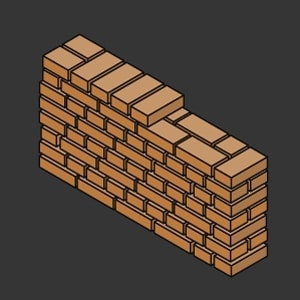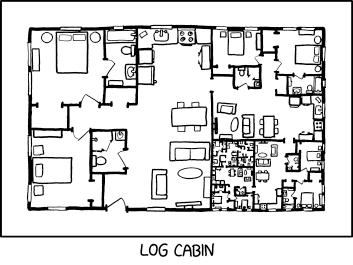Different countries are different
-
Not so much for the logarithmic gag, but this just looks weird to me. En-suite bathrooms are virtually unheard of here, and I'd never expect two bathrooms in a 3-room apartment. There might be a separate toilet, in which case the bathroom would not have one.
At the same time, I'm missing the entryway. Around here, the front door always opens to a small hallway with room for a garderobe, from which you then access the various rooms.
-
@PleegWat said in Different countries are different:
I'd never expect two bathrooms in a 3-room apartment.
I found it difficult to find an apartment that didn't have two bathrooms. I think the expectation here is that people live more crammed together, so if you go for a 2 bedroom place, you're probably sharing somehow.
Apartments are already kinda small here, so losing the extra space to an unnecessary bathroom sucks.
-
@PleegWat said in Different countries are different:
I'd never expect two bathrooms in a 3-room apartment.
If I could turn back time, I'd actually pay for a second toilet set for the separate bathroom. There was an opportunity to have one installed for cheap during the last major pipe renovation project here.
I've had to use the shower drain on way too many mornings.
-
@acrow said in Different countries are different:
I've had to use the shower drain on way too many mornings.
No.
-
@DogsB said in Different countries are different:
@acrow said in Different countries are different:
I've had to use the shower drain on way too many mornings.
No.
Why do I do this to myself?

-
@DogsB said in Different countries are different:
@acrow said in Different countries are different:
I've had to use the shower drain on way too many mornings.
No.
Wife and 2 children. Wife gets her bowel movements in the mornings. One toilet.
-
@PleegWat Most of I know about other countries I learned in this forum, never been too far from home. A few decades ago, before the internet was a big thing, all I knew was from movies, gossip, and propaganda.
I still find interesting that if I see product reviews or ebay, many products are of completely alien brands (for me). Not sure if it's that way everywhere, or because Brazil has one of the highest import tariffs in the world (if not the highest)
The way americans build homes is very different, with internal walls using wood and I think plaster too, and I think it has some extra layers on the external walls. Here it is all brick and concrete, and I'm annoyed with my leaky roof, but that's another thing. I'm guessing part of it is that labor is more expensive there compared to materials, so they shift more of the cost for the materials? No idea how other places do it, there isn't that much construction TV series that I watched with different countries
-
@DogsB said in Different countries are different:
@DogsB said in Different countries are different:
@acrow said in Different countries are different:
I've had to use the shower drain on way too many mornings.
No.
Why do I do this to myself?

Don’t search for the Go With The Flow movement.
-
@sockpuppet7 Around here traditionally you get half-brick or full-brick outer walls without cavity. Inner walls will be half-brick if they're load bearing or wood framing if they are not.
Modern construction has outer walls with cavity; heavy concrete for the inner layer and half-brick for the outer layer. Inner walls are typically a lighter concrete and rarely if ever load bearing, but they may be erected using wood or metal frames and plasterboard as well.
Here half-brick or full-brick refers to the thickness of the walls.

-
@PleegWat said in Different countries are different:
@sockpuppet7 Around here traditionally you get half-brick or full-brick outer walls without cavity. Inner walls will be half-brick if they're load bearing or wood framing if they are not.
Modern construction has outer walls with cavity; heavy concrete for the inner layer and half-brick for the outer layer. Inner walls are typically a lighter concrete and rarely if ever load bearing, but they may be erected using wood or metal frames and plasterboard as well.
Here half-brick or full-brick refers to the thickness of the walls.

I see you have one brick, two brick, and red brick covered. Just need blue brick.

-
@izzion I've seen many tints of brown brick. Yellow is commonly used for accents, and white is sometimes used. But I don't think I've ever seen blue.
-
@sockpuppet7 said in Different countries are different:
The way americans build homes is very different, with internal walls using wood and I think plaster too, and I think it has some extra layers on the external walls.
We don't use plaster any more, except to repair old construction. It's all drywall internally now:
Most single family homes are wood framed, especially in earthquake areas. Masonry is more common in non-earthquake prone areas, though stuff like bricks are usually more cosmetic than structural (some of those extra layers you mention). Concrete blocks with steel reinforcement is common for stuff like firewalls between townhouses that are otherwise wood framed (mine is like this). Bigger buildings (apartments) are more likely to be steel framed, etc.
-
@boomzilla said in Different countries are different:
stuff like bricks are usually more cosmetic than structural
The brick layer won't be load bearing, but it (or rather the cavity between) is still important for thermal isolation.
-
@PleegWat said in Different countries are different:
Here half-brick or full-brick refers to the thickness of the walls.

Those images look wrong to me. My understanding always was full-width has the bricks laid across the thickness of the wall rather than two rows of them.
-
@Bulb Bricks are laid in both directions and there are multiple common patterns. I wasn't fond of the depicted structure but this was my only match which showed both styles. I think this one is better.

-
@Bulb the odd rows do this: they have the end brick across rather than along, so you then get the benefit of the alternating half lengths atop one another.
Having an entire row of across seems like it would be structurally deficient against lateral forces.
-
@boomzilla said in Different countries are different:
Most single family homes are wood framed, especially in earthquake areas. Masonry is more common in non-earthquake prone areas, though stuff like bricks are usually more cosmetic than structural (some of those extra layers you mention). Concrete blocks with steel reinforcement is common for stuff like firewalls between townhouses that are otherwise wood framed (mine is like this). Bigger buildings (apartments) are more likely to be steel framed, etc.
doesn't have a problem with termites? I'm paranoid with termites eating my stuff
-
@sockpuppet7 Wood frame buildings are generally constructed with concrete foundations, so there's no direct contact between wood and soil, and wood that is close to the ground is pressure-treated. That generally stops most termites, unless the occupant does something like altering the landscaping so that soil comes in contact with wood siding, or something. There are buildings that are built on wood foundations, but they're not common (at least not anywhere I've ever lived), and I have to assume they're not used where termites are common. Nevertheless, it's not too unusual to see the occasional house being treated for a termite infestation, usually by being fumigated; such treatment protects the structure for several years. But if the building is properly constructed and maintained, it should be fairly rare.
This all applies to temperate North America. In other climates, termites may be a much bigger problem, so wood construction might be less suitable. I don't know, because I've never lived anywhere other than temperate North America.
-
@sockpuppet7 said in Different countries are different:
@boomzilla said in Different countries are different:
Most single family homes are wood framed, especially in earthquake areas.
doesn't have a problem with termites? I'm paranoid with termites eating my stuff
Framing timber is generally treated (boron and copper/chrome/arsenic are popular choices), with the solution forced into the timber under pressure. It also inhibits rot.
-
Also in some regions (e.g.
 ), termites are not everywhere so in some places it's just not a concern, at all (though there always are other varieties of wood-eating things, but usually much slower and more visible than termites, so easier to handle).
), termites are not everywhere so in some places it's just not a concern, at all (though there always are other varieties of wood-eating things, but usually much slower and more visible than termites, so easier to handle).When buying a property there are a bunch of mandatory inspections, and in some parts of the country this includes a check for termites, but only in parts that are deemed at risk.
That said, I don't think wooden houses are very common here, though in some regions it's part of the traditional style (but even then, modern builds will often be concrete blocks + wooden facing rather than 100% wood). You sometimes see ads for builders making wooden houses, but they're not the majority.
-
@PleegWat said in Different countries are different:
There might be a separate toilet, in which case the bathroom would not have one.
Not to mention that nobody would have a toilet/bathroom that opens immediately into the living room. It’s not actually forbidden by law, as most people think, but it goes against the standards commonly used by municipalities when approving building permits. Toilets are invariably off a hallway or landing, so that there are two doors between the toilet and any areas actually used for living in (sitting rooms, bedrooms, kitchen, etc.).
-
@Gurth here the standard is two doors between toilet and food preparation or eating areas, last I checked but same general sentiment.
-
@Arantor said in Different countries are different:
@Bulb the odd rows do this: they have the end brick across rather than along, so you then get the benefit of the alternating half lengths atop one another.
Having an entire row of across seems like it would be structurally deficient against lateral forces.
The original dutch image is just plain wrong. If you look carefully, every second row consists of square bricks.
-
@Arantor said in Different countries are different:
@Gurth here the standard is two doors between toilet and food preparation or eating areas, last I checked but same general sentiment.
Huh. Not here. A lot of houses are "open plan". My kids/guest bathroom opens off a hallway, not directly off the living room, but there's no door between the hall and the living room, and there are no doors between the living room and the kitchen or dining room. And in a typical studio apartment, the bathroom door may be the only interior door (other than closets) in the whole apartment.
-
@Arantor said in Different countries are different:
@Gurth here the standard is two doors between toilet and food preparation or eating areas
Only in houses as-built, though. I once stayed with someone who lived in a suburb of London, on the first floor of a house that had been split into ground- and first-floor apartments. His bathroom was reached by going through the kitchen. I remember commenting that that would never be allowed in the Netherlands, and IIRC he replied that it wouldn’t normally be in the UK either, but in houses split up like that, it wasn’t that strange.
-
@Gurth Actually, my brother's flat (in NL) was built with the bathroom/laundry room combo accessed through the kitchen.
-
@Kamil-Podlesak said in Different countries are different:
@Arantor said in Different countries are different:
@Bulb the odd rows do this: they have the end brick across rather than along, so you then get the benefit of the alternating half lengths atop one another.
Having an entire row of across seems like it would be structurally deficient against lateral forces.
The original dutch image is just plain wrong. If you look carefully, every second row consists of square bricks.
It depends on which sort of wall you're building. There are variations in the number of cross-bricks and their pattern, but they're definitely needed. More modern construction would probably use concrete breeze blocks for the internal walls and (stainless steel?) ties to link to the outer weatherproof wall.
-
@Kamil-Podlesak said in Different countries are different:
The original dutch
imageis just plain wrong.Yes.
-
Given how much you seem to hate Dutch, I wonder if you've ever worked for a certain Eidhoven-based semiconductor company.
-
@Zerosquare said in Different countries are different:
Given how much you seem to hate Dutch,
Only the throat disease, not the people.
I wonder if you've ever worked for a certain Eidhoven-based semiconductor company.
No. I once worked for a company that was later, after I left, acquired by Philips, but I've never worked for Philips or NXP.
-
@Gurth said in Different countries are different:
@Arantor said in Different countries are different:
@Gurth here the standard is two doors between toilet and food preparation or eating areas
Only in houses as-built, though. I once stayed with someone who lived in a suburb of London, on the first floor of a house that had been split into ground- and first-floor apartments. His bathroom was reached by going through the kitchen. I remember commenting that that would never be allowed in the Netherlands, and IIRC he replied that it wouldn’t normally be in the UK either, but in houses split up like that, it wasn’t that strange.
You see it a lot in the Netherlands in older houses, that originally had no indoor plumbing (< 1900 probably).
Quite often a bathroom was added later in an addition built in what used to be the garden, Since these houses often have the kitchen on that side, the bathroom is accessible through the kitchen only.A long time ago I lived in a house like that, built around 1890. Bathroom was added around the middle of the century I think.
-
@nerd4sale said in Different countries are different:
Bathroom was added around the middle of the century I think.
Reminds me of the first flat my newlywed parents lived in (they only stayed a couple of years and obviously I have no personal memory of it), in an old building in Paris.
It was tiny and cheap, but it had (luxury for the time!) its own toilets and shower (as opposed to a communal one on the landing, as was still commonplace in cheap buildings). I don't remember where the toilets were, but the shower was in the kitchen itself (probably because this is where water pipes were!), with just a shower curtain separating it from the rest. The kitchen overall was so tiny that only person could be in there, and when not in use the shower doubled as storage for various dishes etc.
My parents had a lot of stories of the toilets/bathroom in successive places where they lived (until the 70s, when they got the full "modern" standards), including the outhouse at the end of the garden and the bucket under the bed...
The first time they had a flat with modern amenities, my eldest brother (4 or 5 yo at the time) was so impressed that he told his schoolteacher that "all 3 of us can fit in our new toilets!"
-
@remi said in Different countries are different:
the shower doubled as storage for various dishes etc.
That explains much about the infamous French lack of hygiene.
I should talk, though. My parents grew up before/during the depression, and showering wasn't a daily habit for them, either. My dad told of his father going outside with a bucket of boiling water to thaw the plumbing so he could shower; I have to assume this was far from a daily event. My mom described Saturday night bathing on the farm, with a big washtub in the kitchen. The adults started with clean, hot water; by the time the youngest kid got his/her bath, the water was neither hot nor clean.
-
@HardwareGeek said in Different countries are different:
My mom described Saturday night bathing on the farm, with a big washtub in the kitchen. The adults started with clean, hot water; by the time the youngest kid got his/her bath, the water was neither hot nor clean.
A primary school teacher of mine once told the same story. He was the youngest.
-
@HardwareGeek said in Different countries are different:
My mom described Saturday night bathing on the farm, with a big washtub in the kitchen. The adults started with clean, hot water; by the time the youngest kid got his/her bath, the water was neither hot nor clean.
My mom has a similar story, though the order was more practical: it started with the kids (girls first!) on the assumption that they were the less-dirty, and ended up with grown-up men.
-
@PleegWat said in Different countries are different:
He was the youngest.
My mom was, too (not counting the younger sister who died in infancy).

 Drywall - Wikipedia
Drywall - Wikipedia
